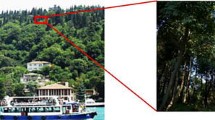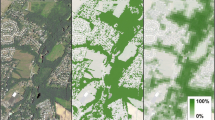Abstract
A method is described to classify stands of eastern hemlock by health condition, at the landscape level, using remote sensing. The hemlock woolly adelgid has been a major cause of hemlock decline in Connecticut since 1985, resulting in varying degrees of defoliation in the region. A 1985 Landsat Thematic Mapper (TM) image was classified to develop a base line of once healthy hemlock stands. Radiance normalization and non-hemlock masking techniques were used to pre-process a 1995 TM image. Several techniques were used to transform the 1995 TM image; each was followed by cluster analysis to separate hemlocks into four levels of tree vigor. We evaluated 600 trees at 150 sites across the study area using the USFS Crown Condition Rating Guide. These field data were used to measure the accuracy of various health classification techniques. The Modified Soil Adjusted Vegetation Index-2 (MSAVI2) transform provided the best overall accuracy, 82.1%, for classifying hemlock according to tree vigor. Non-parametric statistics were used to determine if there were any significant variations in distribution of hemlock pixels by health class in association with features in the landscape. Several features were found to be statistically significant at a confidence level of 0.001. These were aspect of slope, hydrology group (infiltration rate), depth to bedrock, soil order, drainage class (hydraulic conductivity), and surface texture.
Similar content being viewed by others
References
Benzinger J (1994) Hemlock Decline and Breeding Birds. Records of New Jersey Birds 20(1): 2–12
Chavez PS (1988) An Improved Dark-Object Subtraction Technique for Atmospheric Scattering Correction of Multispectral Data. Remote Sensing of the Environment 24: 459–479
Cliff AD and Ord JK (1973) Spatial Autocorrelation. Pion, London
Congalton RG (1991) A review of assessing the accuracy of classifications of remotely sensed data. Remote Sensing of the Environment 37: 35–46
Congalton RG and Green K (1999) Assessing the Accuracy of Remotely Sensed Data: Principles and Practices. Lewis Publishers, Boca Raton, Florida
Crist EP and Cicone RC (1984) Application of the Tasseled Cap concept to simulated Thematic Mapper data. Photogrammetric Engineering and Remote Sensing 50: 343–352
Ebdon D (1990) Statistics in Geography, 2nd edn, Billing and Sons Ltd, Worcester, UK
Goodman RM and Lancaster K (1990) Tsuga canadensis — Eastern Hemlock in Silvics of North America: Vol 1 Conifers. USDA Forest Service Agriculture Handbook 654
Jenkins JC, Aber JD and Canham CD (1999) Hemlock woolly adelgid impacts on community structure and N cycling rates in eastern hemlock forests. Canadian Journal of Forest Research 29: 630–645
Joria PE, Ahearn SC and Connor M (1991) A comparison of the SPOT and Landsat Thematic Mapper satellite systems for detecting gypsy moth defoliation in Michigan. Photogrammetric Engineering and Remote Sensing 57: 1605–1612
Jorgensen N (1978) A Sierra Club Naturalist's Guide — Southern New England. Sierra Club Books, San Francisco, California, 417 pp
Legendre P (1993) Spatial autocorrelation: Trouble or new paradigm? Ecology 74(6): 1659–1673
Liebhold AM, Hohn E and Gribko LS (1993) Forecasting the spatial dynamics of gypsy moth defoliation using 3-dimensional kriging. In: Liebhold AM and Barrett HR (eds) Proceedings: Spatial Analysis and Forest Pest Management, Mountain Lakes, Virginia, USA, 27–30 April 1992, USDA Forest Service General Technical Report NE-175, pp 150–159
McClure M (1987) Hemlock woolly adelgid may also attack spruce. Frontiers of Plant Science. Connecticut Agricultural Experiment Station, New Haven, Connecticut 39: 7–8
McClure M (1989) Evidence of a polymorphic life cycle in the hemlock woolly adelgid, Adelges tsugae (Homoptera: Adelgidae). Annals of the Entomological Society of America 82: 50–54
McClure M (1991) Density-dependent feedback and population cycles in Adelges tsugae (Homoptera: Adelgidae) on Tsuga canadensis. Environmental Entomology 20: 258–264
Millers I, Anderson R, Burkman W and Hoffard W (1992) Forest Health Monitoring, Crown Condition Rating Guide. USDA Forest Service. State and Private Forestry Northeastern Area and Southern Region
Muchoney, DM and Haack BN (1994) Change detection for monitoring forest defoliation. Photogrammetric Engineering and Remote Sensing 60: 1243–1251
Orwig DA and Foster DR (1998) Forest response to the introduced hemlock woolly adelgid in southern New England, USA. Journal of the Torrey Botanical Society 125(1): 60–73
Qi J, Chehbouni A, Huete AR, Kerr YH and Sorooshian S (1994) A modified soil adjusted vegetation index. Remote Sensing of the Environment 48: 119–126
Ray TW (1994) A FAQ on Vegetation in Remote Sensing 〈ftp://kepler.gps.caltech.edu/pub/terrill/rsvegfaq.txt〉 (March 18, 1996)
Reich RM and Geils BW (1993) Review of spatial analysis techniques. In: Liebhold AM and Barrett HR (eds) Proceedings: Spatial Analysis and Forest Pest Management, Mountain Lakes, Virginia, USA, 27–30 April 1992, USDA Forest Service General Technical Report NE-175, pp 142–149
Royle DD and Lathrop RG (1997) Monitoring hemlock forest health in New Jersey using Landsat TM data and change detection techniques. Forest Science 43(3): 327–335
Smith RL (1990) Ecology and Field Biology, 4th edn, HarperCollins
Suoto D, Luther T and Chianese R (1996) Past and current status of HWA in Eastern and Carolina Hemlock Stands, In: Salmon SM, Tigner TC and Reardon RC (eds) Proceedings of the First Hemlock Woolly Adelgid Review, Charlottesville, Virginia, USA, 12 October 1995, USDA Forest Service, Forest Health Technology Team, Morgantown, West Virginia, pp 9–15
Young, RF, Shields KS and Berlyn GP (1995) Hemlock woolly adelgid (Homoptera: Adelgidae): stylet bundle insertion and feeding sites. Annals of the Entomological Society of America 88: 827–835
Author information
Authors and Affiliations
Rights and permissions
About this article
Cite this article
Bonneau, L.R., Shields, K.S. & Civco, D.L. Using Satellite Images to Classify and Analyze the Health of Hemlock Forests Infested by the Hemlock Woolly Adelgid. Biological Invasions 1, 255–267 (1999). https://doi.org/10.1023/A:1010021629127
Issue Date:
DOI: https://doi.org/10.1023/A:1010021629127




